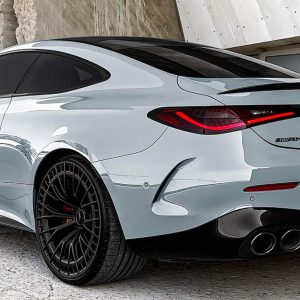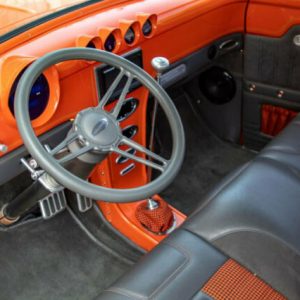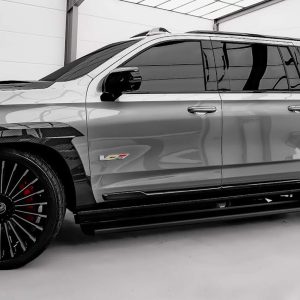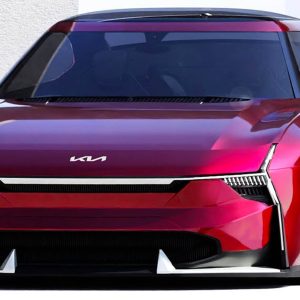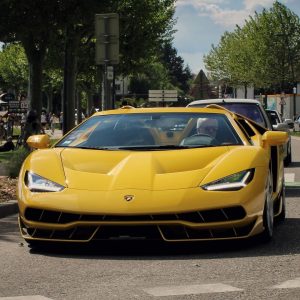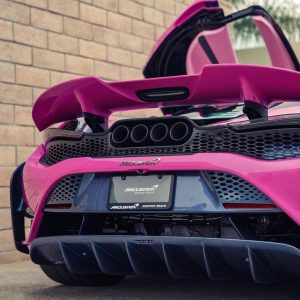
Never miss an issue of Classic & Sports Car and save money when you subscribe! Check out our latest offers
Peering through the gap in the steering wheel at the obscured tachometer, you put the hammer down and the revs of the coarse V8 behind your head climb furiously.
The engine feels as if it can keep on revving, but the redline disagrees.
Dip the clutch and the car dives forward slightly, freed from the accelerative forces pushing it on to its haunches, but the gearlever can be thrown, with a satisfying clack through its stainless-steel gate, quickly into the next ratio then more power sends the car squatting on its rear axle again.

Tom Tjaarda’s angular design is set off by a striking Arancione a Molla (spring orange) hue
The front end visibly lifts, feeling increasingly floaty and encouraging you to brake hard before the approaching corner.
Downshift straight to second – directly upwards from the lever’s resting state – and it’s a case of pitching the car in with as much delicacy as your talent can muster, balancing the fiery power of the engine with adhesion to the greasy road.
For the layperson, the De Tomaso Pantera transforms any local B-road into the Circuit de la Sarthe, conjuring images of Ford GT40s, Ken Miles and night-time motorsport heroics.
It’s slightly embarrassing, as a grown adult, to admit to fantasies of driving racing cars, but that’s exactly what the Pantera inspires.
By the late ’60s, Ford was desperate for an exotic-looking halo car to compete with the Chevrolet Corvette, not just to stop the General from gaining a march, but also to capitalise on the truly remarkable sporting success of the Shelby-Ford GT40s at Le Mans.
American buyers, now awakened to the glamour and speed of European endurance racing, wanted a piece of that success on their driveways.

The crisply styled nose with neat quarter-bumpers on the ‘pre-L’, before a much-needed front splitter was added
The Blue Oval’s original plan had been to buy Ferrari, win races as ‘Ferrari-Ford’ and then have a range of Latin-influenced exotic road cars to sell.
Famously, it didn’t work out like that, though the marketing value of the Ford GT40 probably proved greater than any tie-in with Modena ever would have. The GT40, however, couldn’t be mass-produced as a road car, and Dearborn bosses still hadn’t quite given up on their Italian dreams, either.
The relationship between De Tomaso and Ford didn’t begin with the Pantera. Alejandro De Tomaso had approached the US giant to use Cortina engines in his first road car, the Vallelunga, in 1963.

A Cleveland V8 is wedged close to the De Tomaso’s seats
There was a further project, sadly cancelled, to see the Shelby King Cobra receive an Italian body.
De Tomaso’s second road car, the Mangusta, was again Ford-powered, this time a V8, while its chassis was designed by Peter Brock of Shelby American.
The trio of Ford, Shelby and De Tomaso was closely connected, and the former’s senior exec Lee Iacocca in particular was keen to collaborate more closely with De Tomaso.
Any car that Ford was to sell from its dealerships would have to be less of a specialist product than the expensive and compromised Mangusta, however.
De Tomaso was tasked with building a mid-engined GT that made use of a simpler steel monocoque chassis rather than the spaceframes it was used to, and it would need to have an interior comfortable enough for demanding American consumers.
Ford finalised the relationship in 1970 as it bought an 80% stake in De Tomaso’s holding group, which included Vignale and Ghia, with Iacocca taking overall control of this Italian offshoot of the Ford empire while De Tomaso stayed at the head of his own marque.
The new Pantera would be sold via Lincoln-Mercury dealers in North America; everywhere else, De Tomaso was free to sell the car on his own.

This Italian-supplied car is fitted with an elegant three-spoke wheel
A hybrid in the classic sense of the word, the Pantera is an Italian body and chassis mated to an American engine: at the heart of the collaboration is the Cleveland 351cu in ‘High Output’ V8.
Created for the Boss Mustang, the HO version of Ford’s Cleveland unit has gone down as one of the company’s great V8s – a last hurrah before the ‘malaise’ era of smog control and fuel crises.
It’s this lump that sets the Pantera apart from its Italian rivals, and it’s one that announces itself straight away. At every rev it is unmistakably an American V8 in its soundtrack: loud and rambunctious even at a standstill, rumbling the very earth beneath it with the slow beat of its pistons.

Inside, the Pantera’s scattergun dash can be forgiven thanks to an evocative gear gate
That character continues on the road, where the big V8 provides tractable power from low down in the rev range.
It’s fair to say that these early Panteras have a reputation for being a bit of a handful, so you lean on the throttle lightly at first, but it’s a surprisingly easy car to drive gently.
The steering is reasonably light, and there’s a friendly playfulness to the chassis that quickly inspires confidence.
It feels more agile than you might expect, much narrower than many supercar contemporaries and with excellent vision (except rearwards) – though it’s at its best racing down the straights between tight corners.
On flowing bends it tends to understeer, and it’s worse in the wet unless you stamp on the throttle in a low gear, but the steering is precise enough to place it accurately within a corner – as long as you’ve scrubbed off enough speed.
That lazy burble rises to an animalistic roar immediately behind your head as you push the car harder, and it’s a joy to exercise the V8 via the classic gated gearshift.
With a dog-leg first, the fantastic ZF gearbox is slick, tight and, while surprisingly light to use, it also tolerates a heavy shove into gear in the heat of the moment.
Only the clutch mars its friendly nature: it’s a bit on the heavy side, as you might expect, but worse is the excessively long travel required to engage it.
With so much torque on tap, though, you can just leave it in third for a gentle drive around town. Its relative ease in everyday use was key to Ford, and sets the De Tomaso apart from the Lamborghinis and Ferraris it sought to challenge.
Further evidence of its practicality is to be found at the back of the Pantera. The huge rear deck lifts to reveal a large boot that would have compared favourably to a Miura, all thanks to the placement of the relatively compact pushrod V8.

The early De Tomaso Pantera’s slender arches were lost on later models
Free from bulky overhead cams, the De Tomaso’s engine nestles low and well forward, beneath a trimmed cover panel, with the gearbox stretching under the boot floor.
Once you’ve slung in some soft bags, the suspension adds to its touring credentials by being comfortable beyond compare in a car of such sporting intent: a bit firm at low speeds, perhaps, but compliant once up to a cruise.
Interior ventilation is better than many of its pricier competitors, with face-level vents and air conditioning commonly fitted (though not in this early, Italian-delivered car).

‘That lazy burble rises to an animalistic roar immediately behind your head as you push the car harder’
De Tomaso took the GT brief seriously: the Pantera needed to appeal on the highway, as well as on a challenging back-road. Long gearing gives 70mph at around 2600rpm in top, allowing the De Tomaso to settle into a relaxed lope when the driver isn’t in the mood for histrionics.
Some details do reveal aspects of cost-cutting – perhaps inevitable in the first mass-produced model from a young manufacturer.
Many of the switches on the dash, for example, are rockers clearly designed to be mounted vertically, turned on their side, while the window controls are crammed into such a tight spot that the two rectangular units don’t sit quite parallel.
Even with this bodge, De Tomaso was still forced to mount the radio – here an off-the-shelf Becker unit – in an odd vertical orientation. To any criticism, Alejandro De Tomaso responded that it was impossible to build a truly exotic car for the Pantera’s price without such compromises.
So often with classics, the first edition is the best. It’s the closest to the creator’s original vision, before the car gets pulled in different directions by legislation and often ham-fisted attempts to update the styling to reflect recent trends.
But they can be the most troublesome, too, and few cars epitomise this split appeal better than the earliest ‘pre-L’ Pantera. With its narrow flanks, missing the bulging arches of later cars, and elegant metal bumpers, it is undoubtedly the most beautiful version of the Pantera.
Tom Tjaarda’s angular design for Ghia was ferociously modern in 1970, and still looks fresh even alongside younger cars such as Marcello Gandini’s Countach or Giorgetto Giugiaro’s BMW M1, yet also nods to its muscle-car ancestry with hints of the 1971 Mustang fastback in its C-pillar.
And the beauty is more than skin-deep. Unusually, these early Panteras have a rear footprint narrower than the front, and this plus the slim tyres and low overall weight provide the agility and lighter steering that are key to the car’s amiable character.
It’s impossible to completely overlook the obvious shortcomings in the hastily developed Pantera’s design, however. The delicate nose is worryingly light at speed, in drastic need of the front splitter the car later received, while the cooling system proved marginal even when in good working order.
There are ergonomic challenges, too, that harm the car’s promised usability. As well as that hefty clutch, the main gauges are obscured by the steering wheel, and the helm itself is both offset and mounted at an awkward angle.
Ford couldn’t tolerate such glitches for long, and in ’72 the Pantera L was introduced, rectifying these issues as well as promising better overall build quality.
Unfortunately, the Pantera L also had to deal with new Federal regulations that forced upon it unsightly impact bumpers, higher-riding suspension and smog-strangling of the engine.

Narrow track and skinny tyres give early Panteras an ‘on tiptoes’ look that was lost in later, more muscular versions
With the exception of the comparatively small number of Pantera Ls built for Europe, which managed to escape such compromises, the L proved to be one step forward and two back.
While later Panteras no doubt provided a better ownership experience, and with two decades of development became faster, fire-spitting machines of terrifying performance, the early cars remain a special glimpse into Alejandro’s original vision, an elegant and delicate-handling super-GT that could have been as ubiquitous and easy to use as a Corvette.
The life cycle of a Panther

The ‘pre-L’ Pantera was launched in 1970
1970-’72 The Pantera is first revealed in Modena in March 1970, and in New York a few weeks later.
The race-inspired chassis with all-independent suspension is by Gian Paolo Dallara, poached from Lamborghini.
The first production cars come in 1971, with 3000 built before the model is updated.

The Pantera L rectified quality issues © Getty
1972-’74 To address complaints about the first cars, which American journalists label ‘unfinished’, the Pantera L – for lusso, or luxury – is introduced.
Many quality issues are resolved and it is well received in the US, though its engine and looks are altered to meet Federal regulations (above).

Pantera GTS gets more power and quicker steering
1973-’85 The more aggressive Pantera GTS is unveiled, initially for the European market only, with a wider track, quicker steering and a 350bhp V8.
The US market gets 150 in 1974, but with the L’s engine. Later in the year Ford pulls out of the Pantera agreement, but De Tomaso continues selling the GTS until 1985.

Motorsport-inspired upgrades are apparent on the Pantera GT5
1980-’85 The Pantera GT5 puts developments from De Tomaso’s motorsport activities into a reworked chassis.
The car’s appearance drastically changes, with much wider wheelarches, side air intakes and a huge rear wing.

Pantera GT5S gets modified bodywork and updated interior
1984-’90 For the first time since its launch, the Pantera’s bodywork is altered, with the widened arches now integrated into the steel wings for the GT5S.
The interior is redesigned to be more luxurious, with the emphasis shifting from outright performance to a sports GT.

The Pantera is redesigned by Marcello Gandini to create the 90 Si
1990-’93 Marcello Gandini is called in to redesign the bodywork more thoroughly and the car moves to a tubular chassis as it is renamed the Pantera 90 Si.
The Cleveland V8 is replaced with a 5-litre fuel-injected engine, as found in the Ford Mustang.
Just 41 examples are built before De Tomaso discontinues the model to build the Guarà.
